Investigation of the Energy Performance of a Novel Modular Solar Building Envelope
Abstract
:1. Introduction
1.1. Modular System Based on Solar Thermal Collector
1.2. Modular System Based on Solar Photovoltaic/Thermal Collector
1.3. Summary of Deficiencies in Existence
2. Concept and Approach
2.1. Concepts of the Design
2.2. Information of the Components
2.3. Module Installation
3. System Descriptions
3.1. Outdoor Part
3.2. Indoor Part
4. Data Analysis of Solar Envelope Structure Module
4.1. Simulation Data of Module Energy Consumption
4.1.1. Establishment of Mathematics Model
4.1.2. Simulation of Energy Consumption of Envelope Module Structure
4.2. Efficiency of the Modular System
4.2.1. Mathematical Model of Energy Transfer and Transformation Process
- The system is in quasi-steady-state;
- The surface area of all material layers has the same temperature;
- The fluid in the pipe is in forced circulation;
- The heat loss due to the superior thermal resistance of the insulation layer is ignored.
4.2.2. Efficiency Comparison of Solar Building Envelope Module, Conventional Solar Thermal System, PV, and PV/T
5. Conclusions
Author Contributions
Conflicts of Interest
References
- Roaf, S.; Brotas, L.; Nicol, F. Counting the costs of comfort. Build. Res. Inf. 2015, 43, 269–273. [Google Scholar] [CrossRef]
- Proposal for a Recast of the EPBD, Impact Assessment; European Communities: Brussels, Belgium, 2008.
- Peng, Y.; Wang, L.; Wang, W.; Cheng, L. Research progress of flat-plate solar collectors. Energy Energy Conserv. 2011, 8, 15–16. [Google Scholar]
- Zhu, D.; Yan, D. Calculation of solar radiation and generated energy on inclined plane and optimal inclined angle. Build. Sci. 2012, 28, 277–280. [Google Scholar]
- The Future of Heating: Meeting the Challenge. Available online: http://www.buildup.eu/en/practices/publications/future-heating-meeting-challenge-uk-heat-strategy (access on 19 June 2017).
- Shukla, R.; Sumathy, K.; Erickson, P.; Gong, J. Recent advances in the solar water heating systems: A review. Renew. Sustain. Energy Rev. 2013, 19, 173–190. [Google Scholar] [CrossRef]
- MacLeay, I.; Harris, K.; Annut, A. Digest of UK Energy Statistics 2012. Available online: https://www.gov.uk/government/statistics/digest-of-united-kingdom-energy-statistics-dukes-2012-printed-version-excluding-cover-pages (access on 19 June 2017).
- European Solar Thermal Technology Platform. Available online: http://www.solarthermalworld.org/keyword/european-solar-thermal-technology-platform (access on 19 June 2017).
- Zhang, X.; Shen, J.; Lu, Y.; He, W.; Xu, P.; Zhao, X.; Qiu, X.; Zhu, Z.; Zhou, J.; Dong, X. Active solar thermal facades (ASTFs): From concept, application to research questions. Renew. Sustain. Energy Rev. 2015, 50, 32–63. [Google Scholar] [CrossRef]
- Ibrahim, M.; Wurtz, E.; Anger, J.; Ibrahim, O. Experimental and numerical study on a novel low temperature facade solar thermal collector to decrease the heating demands: A south-north pipe-embedded closed-water-loop system. Solar Energy 2017, 147, 22–36. [Google Scholar] [CrossRef]
- Wolf, M. Performance analysis of combined heating and photovoltaic power systems for residences. Energy Convert. 1976, 16, 79–90. [Google Scholar] [CrossRef]
- Florschuetz, L.W. Extension of the Hottel-Whiller model to the analysis of combined photovoltaic/thermal flat plate collectors. Solar Energy 1979, 22, 361–366. [Google Scholar] [CrossRef]
- Clarke, J.A.; Hand, J.W.; Johnstone, C.M.; Kelly, N.; Strachan, P.A. Photovoltaic-integrated building facades. Renew. Energy 1996, 8, 475–479. [Google Scholar] [CrossRef]
- Fujisawa, T.; Tani, T. Annual exergy evaluation on photovoltaic-thermal hybrid collector. Solar Energy Mater. Solar Cells 1997, 47, 135–148. [Google Scholar] [CrossRef]
- Dupeyrat, P.; Menezo, C.; Fortuin, S. Study of the thermal and electrical performances of PVT solar hot water system. Energy Build. 2014, 68, 751–755. [Google Scholar] [CrossRef]
- Fraisse, G.; Menezo, C.; Johannes, K. Energy performance of water hybrid PV/T collectors applied to combisystems of direct solar floor type. Solar Energy 2007, 81, 1426–1438. [Google Scholar] [CrossRef]
- Kazanci, O.B.; Skrupskelis, M.; Sevela, P.; Pavlov, G.K.; Olesen, B.W. Sustainable heating, cooling and ventilation of a plus-energy house via photovoltaic/thermal panels. Energy Build. 2014, 83, 122–129. [Google Scholar] [CrossRef]
- Liao, W.; Ye, Y.; Shi, X.; Cui, H. Experimental study on influence of phase change material on the temperature of wall with photovoltaics. Build. Energy Effic. 2014, 8, 47–51. [Google Scholar]
- Li, J.; Wang, D.; Peterson, G.P. Experimental studies on a high performance compact loop heat pipe with a square flat evaporator. Appl. Therm. Eng. 2010, 30, 741–752. [Google Scholar] [CrossRef]
- Lu, X.; Hua, T.-C.; Liu, M.; Cheng, Y. Thermal analysis of loop heat pipe used for high-power LED. Thermochimica Acta 2009, 493, 25–29. [Google Scholar] [CrossRef]
- Yang, J.; Liu, Y.; Gu, M.; Peng, L.; Zhang, Y.; Gao, T. Research on cooling technology of solar photovoltaic cells. East China Electr. Power 2011, 39, 81–85. [Google Scholar]
- Rohsenow, W.; Hartnet, J.; Cho, Y. Handbook of Heat Transfer, 3rd ed.; McGraw-Hill: New York, NY, USA, 1998. [Google Scholar]
- Kumar, R. Estimation of solar collector area and thermal energy requirement in absorber heat recovery cycle. Heat Recovery Syst. CHP 1998, 8, 69–74. [Google Scholar] [CrossRef]
- Kalogirou, S. Economic analysis of solar energy systems using spread sheets. Renew. Energy 1996, 9, 1303–1307. [Google Scholar] [CrossRef]
- Luo, Q.; Tang, G.; Gong, G.; Tang, H. Analysis on energy saving approach for building hot water. Gas Heat 2004, 24, 3–5. [Google Scholar]
- Wu, R.; Yue, L.; Li, Q. Comparison of direct and indirect sewage source heat pump systems. HV AC 2011, 41, 111–114. [Google Scholar]



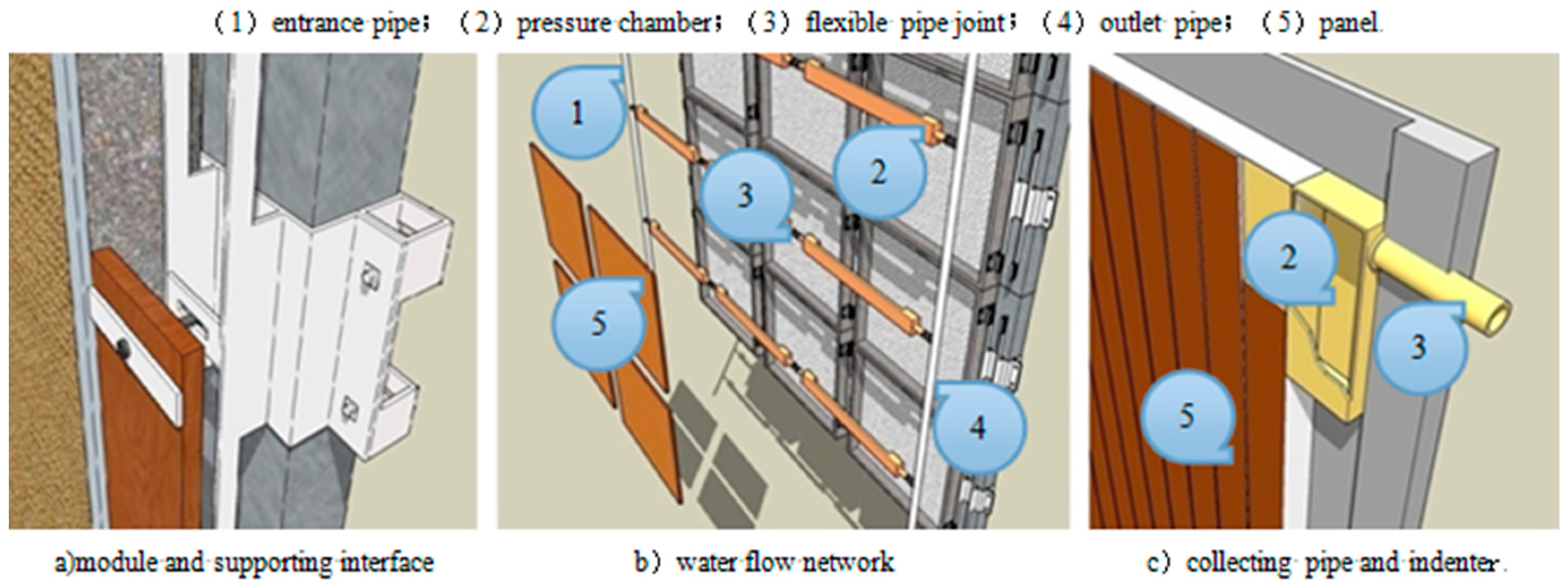
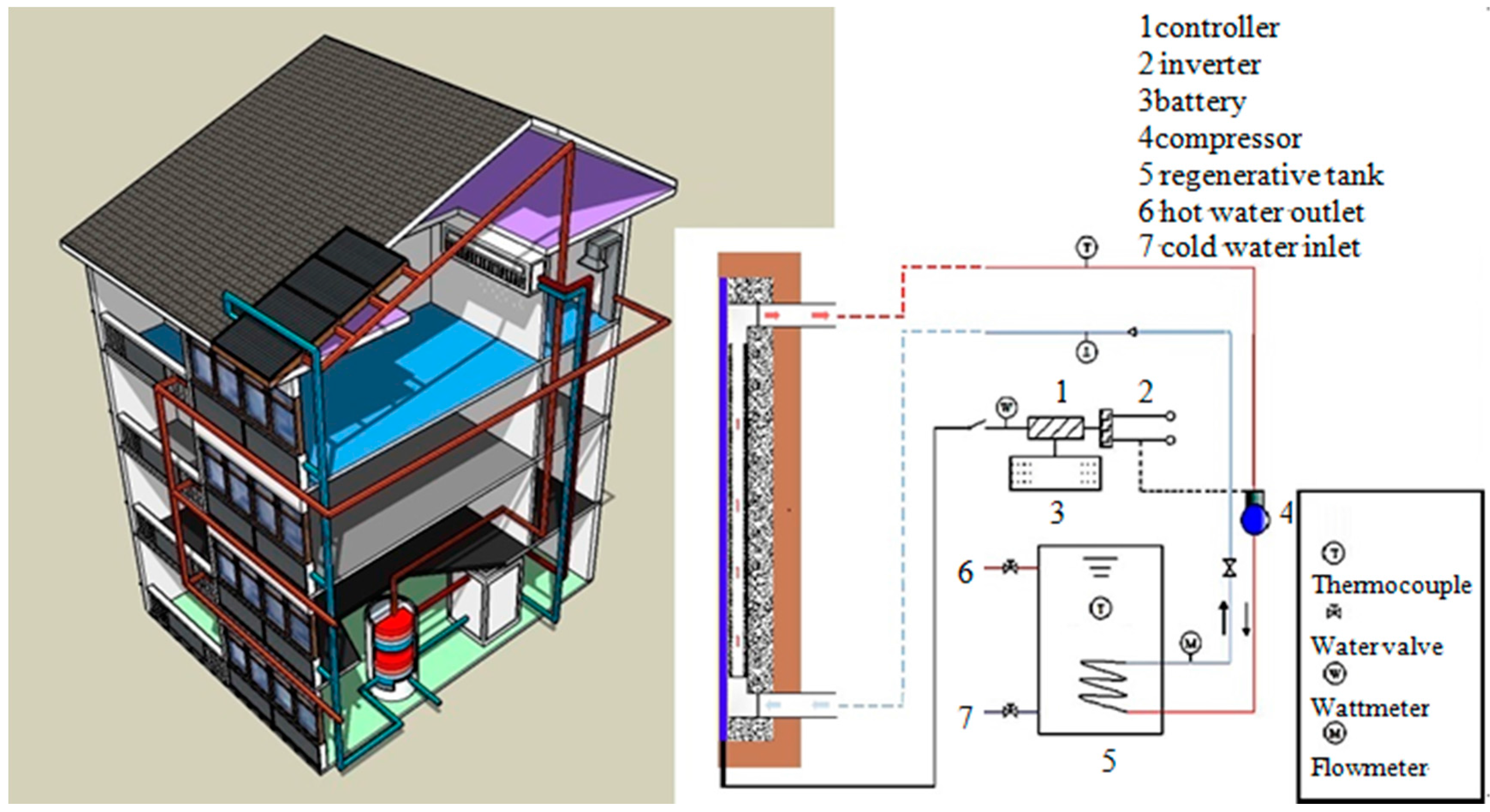

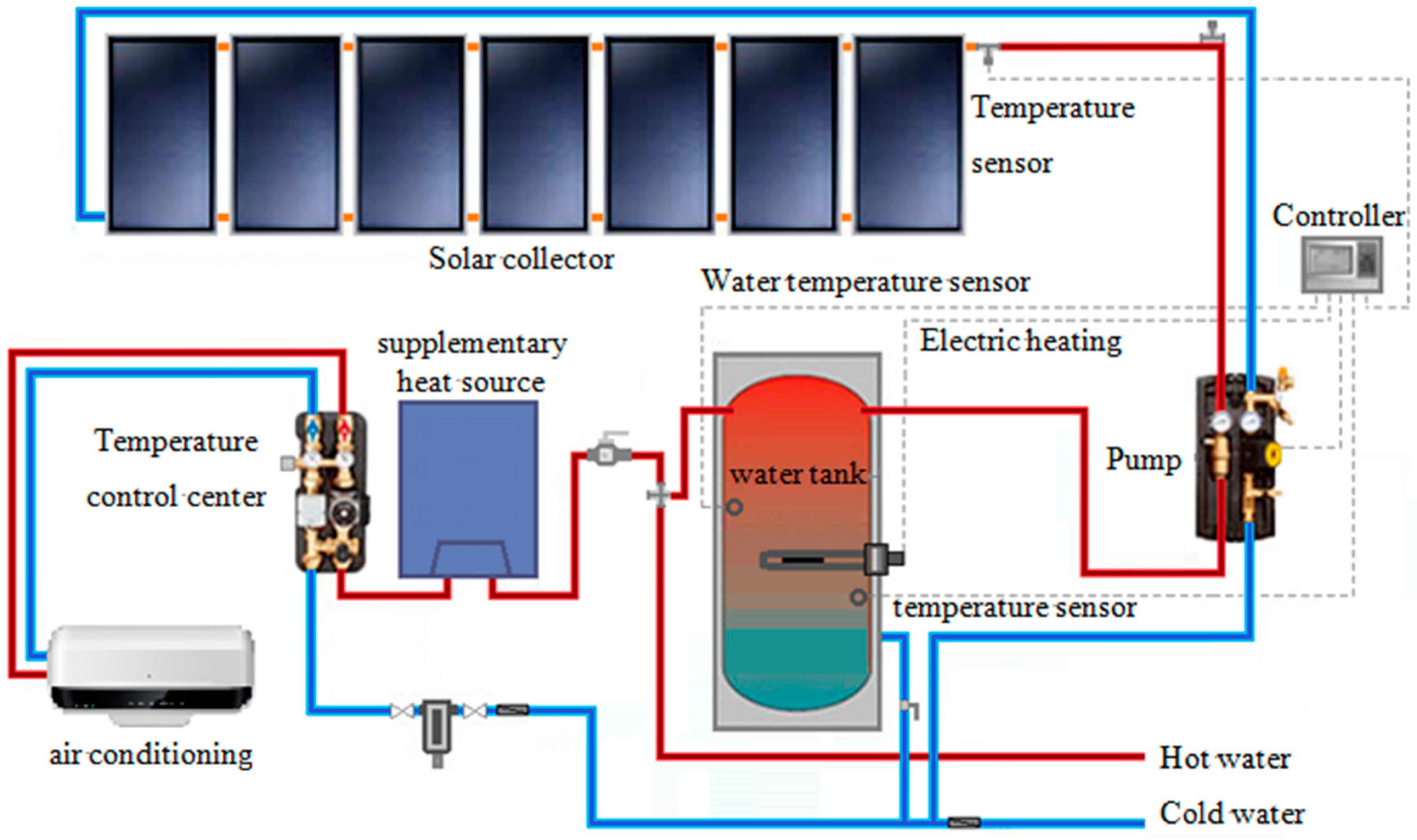

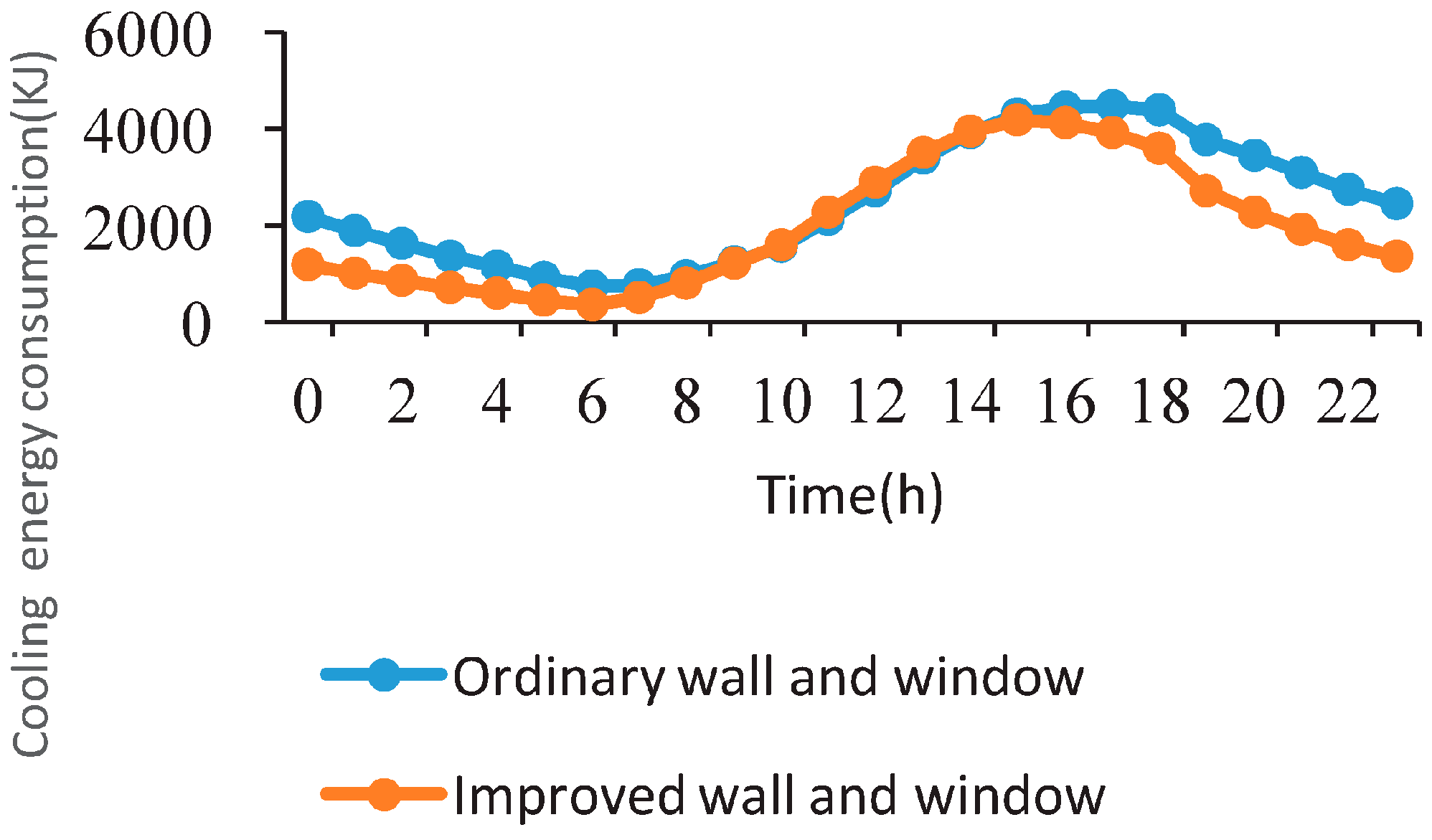
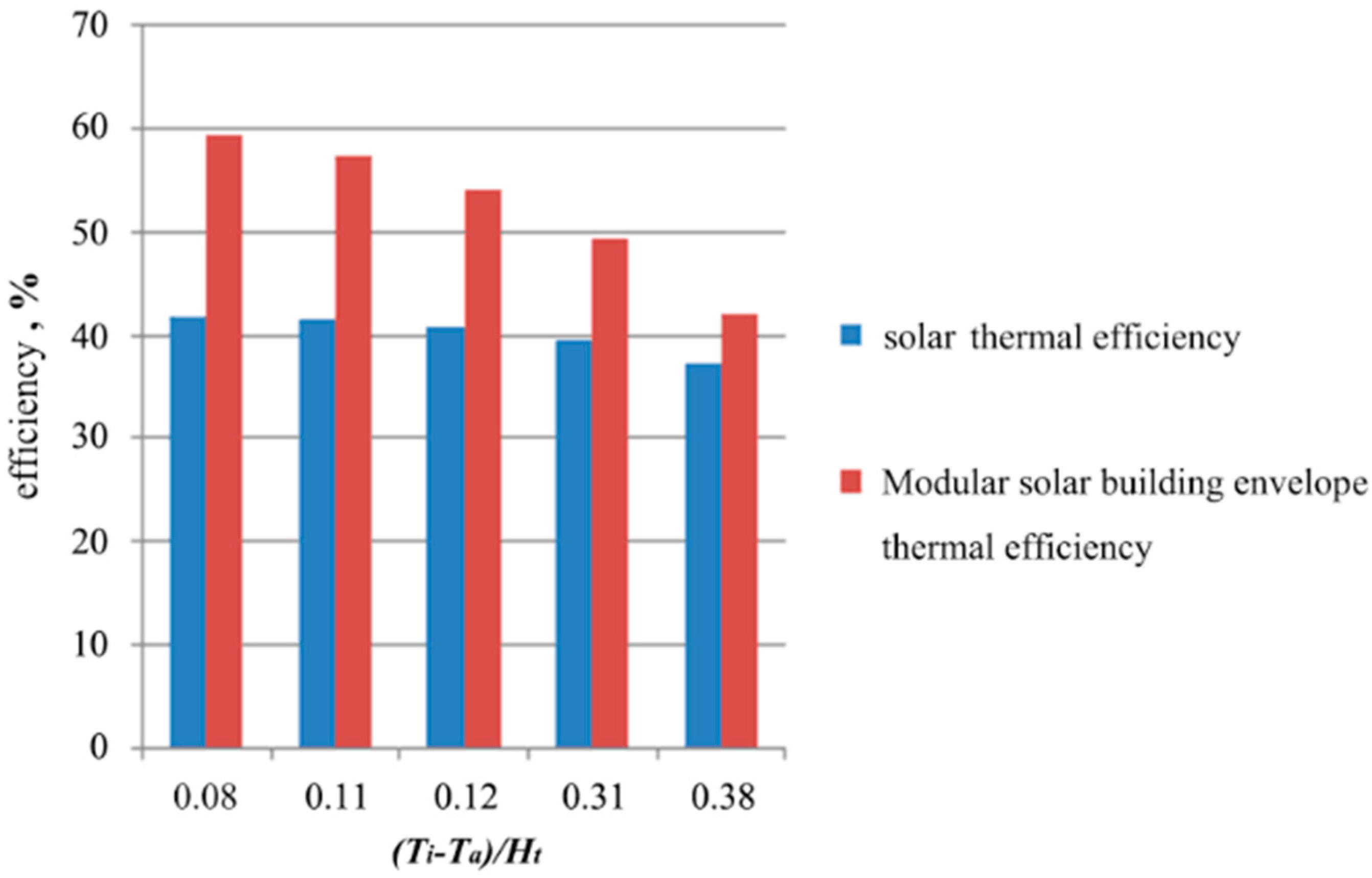
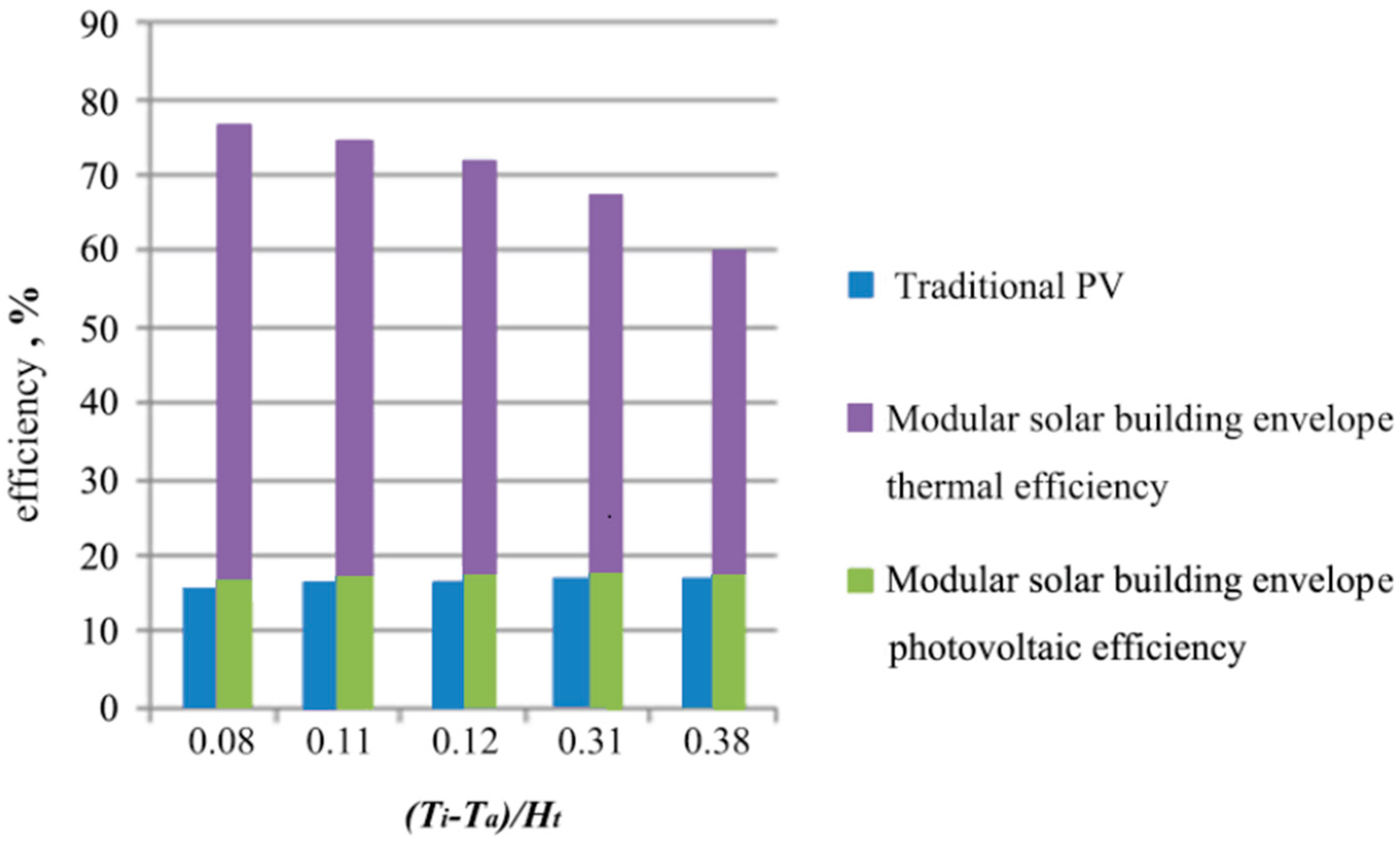
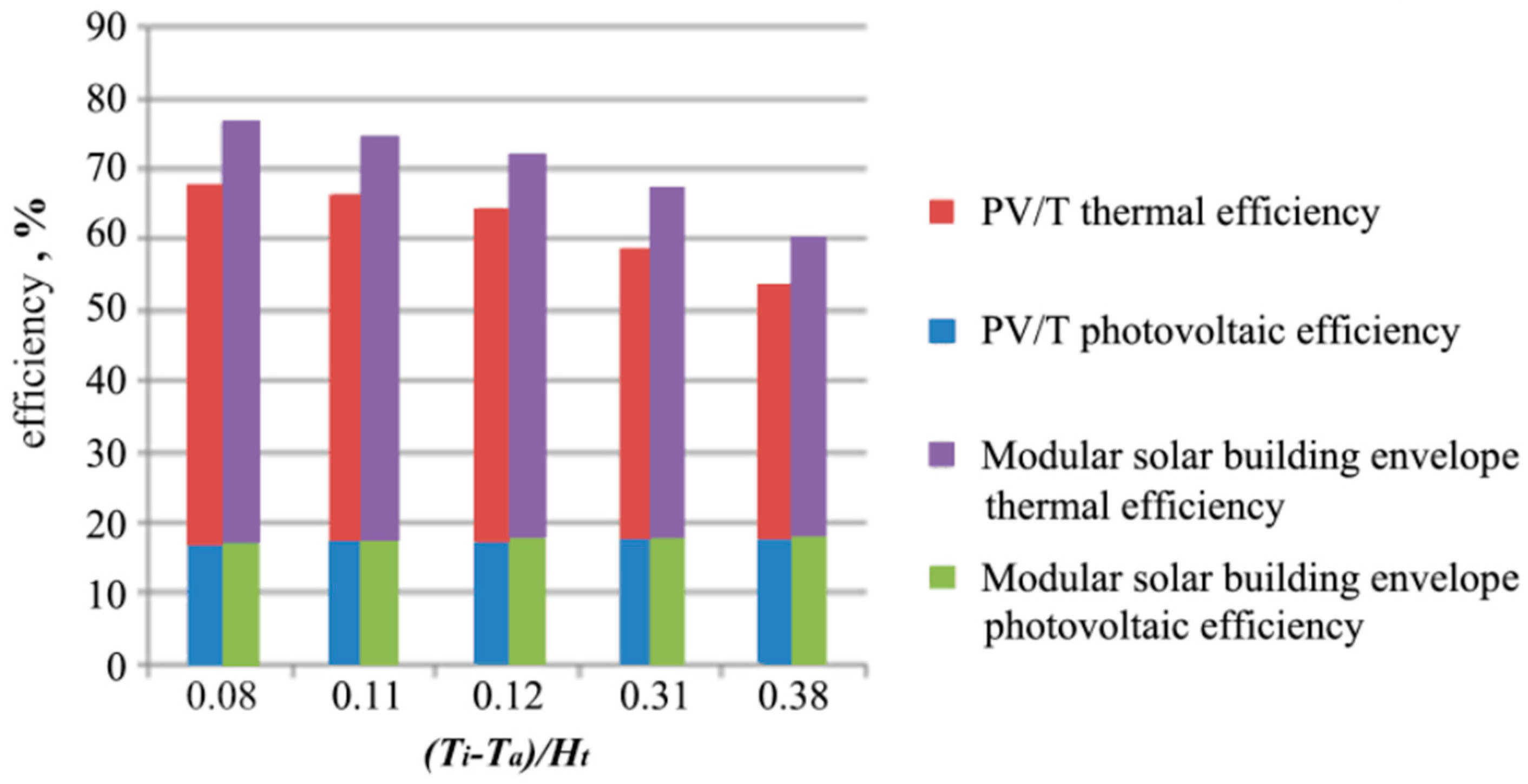
| Type/Structural Diagrams | Operational Features |
|---|---|
 |
|
Active-unglazed solar façade
|
| Type/Structural Diagrams | Operational Features |
|---|---|
 |
|
Englert Solar Sandwich
|
| Envelope Element | Original Parameters | Parameters of Module-Building Integration System |
|---|---|---|
| Exterior walls | 5 mm-thick thermal insulation coating +20 mm thick cement mortar +180 mm-thick aerated block +20 mm-thick cement mortar | 3 mm-thick fluorocarbon aluminum veneer decorative board +70 mm-thick rock wool board +25 mm-thick synthetic resin decorative board +120 mm-thick polyurethane insulation board +25 mm-thick synthetic resin decorative board |
| Floors | 100 mm-thick reinforced concrete floor | 100 mm-thick reinforced concrete floor |
| Roof | 100 mm-thick reinforced concrete floor +10 mm-thick polystyrene thermal insulation | 3 mm-thick fluorocarbon aluminum veneer decorative board +70 mm-thick rock wool board +25 mm-thick synthetic resin decorative board +120 mm-thick polyurethane insulation board +25 mm-thick synthetic resin decorative board |
| Window | Window/wall ratio: 55% south, north 55% | Window/wall ratio: 55% south, north 55% |
| Structure | Parameter | Numerical Value |
|---|---|---|
| PV cell | Battery efficiency under standard operating conditions | 15 |
| PV cell temperature coefficient/K−1 | 0.0040 | |
| Thickness/m | 0.0003 | |
| Collector | Emissivity % | 84 |
| Absorptivity % | 90 | |
| Equivalent thermal conductivity (W·m−1·K−1) | 198 | |
| Equivalent thickness/m | 0.001 | |
| Flat tube | Flat tube thickness/m | 0.01 |
| Flat tube length/m | 0.02 | |
| Junction thermal resistance/(m2·K·W−1) | 0 | |
| Heat transfer coefficients inside a tube/(W·m−2·K−1) | 300 | |
| Fluid heat capacity inside a tube/(kJ·kg−1·K−1) | 4.2 | |
| Heat insulation layer | Thermal conductivity (W·m−1·K−1) | 0.045 |
| Bottom insulation thickness/m | 0.030 | |
| Edge insulation thickness/m | 0.025 | |
| External fixing frame | Thermal conductivity (W·m−1·K−1) | 0.04 |
| Bottom frame thickness/m | 0.025 | |
| Edge frame thickness/m | 0.025 |
© 2017 by the authors. Licensee MDPI, Basel, Switzerland. This article is an open access article distributed under the terms and conditions of the Creative Commons Attribution (CC BY) license (http://creativecommons.org/licenses/by/4.0/).
Share and Cite
Ren, G.; Zhao, X.; Zhan, C.; Jin, H.; Zhou, A. Investigation of the Energy Performance of a Novel Modular Solar Building Envelope. Energies 2017, 10, 880. https://doi.org/10.3390/en10070880
Ren G, Zhao X, Zhan C, Jin H, Zhou A. Investigation of the Energy Performance of a Novel Modular Solar Building Envelope. Energies. 2017; 10(7):880. https://doi.org/10.3390/en10070880
Chicago/Turabian StyleRen, Gang, Xudong Zhao, Changhong Zhan, Hong Jin, and Aishen Zhou. 2017. "Investigation of the Energy Performance of a Novel Modular Solar Building Envelope" Energies 10, no. 7: 880. https://doi.org/10.3390/en10070880




